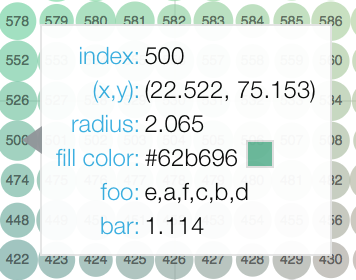Configuring plot tools¶
Bokeh comes with a number of interactive tools that you can use to report information, to change plot parameters such as zoom level or range extents, or to add, edit, or delete glyphs. Tools can be grouped into four basic categories:
- Gestures
These tools respond to single gestures, such as a pan movement. The types of gesture tools are:
For each type of gesture, only one tool can be active at any given time. The active tool is highlighted on the toolbar next to the tool icon.
- Actions
These are immediate or modal operations that are only activated when their button in the toolbar is pressed, such as the
ResetTool.- Inspectors
These are passive tools that report information or annotate plots in some way, such as the
HoverToolorCrosshairTool.- Edit tools
These are sophisticated multi-gesture tools that can add, delete, or modify glyphs on a plot. Since they may respond to several gestures at once, an edit tool when activated will potentially deactivate multiple single-gesture tools.
This chapter contains information about all the individual tools and describes how the toolbar may be configured.
Positioning the toolbar¶
By default, Bokeh plots come with a toolbar above the plot. You can change the location of the toolbar or remove it.
You can specify the toolbar location by passing the toolbar_location
parameter to the figure() function. Valid values are:
"above""below""left""right"
If you would like to hide the toolbar entirely, pass None.
The code below positions the toolbar below the plot. Try
running the code and changing the toolbar_location value.
from bokeh.plotting import figure, output_file, show
output_file("toolbar.html")
# create a new plot with the toolbar below
p = figure(width=400, height=400,
title=None, toolbar_location="below")
p.circle([1, 2, 3, 4, 5], [2, 5, 8, 2, 7], size=10)
show(p)
Note that the toolbar position clashes with the default axes. In this case,
setting the toolbar_sticky option to False will move the toolbar
outside of the area where the axis is drawn.
from bokeh.plotting import figure, output_file, show
output_file("toolbar.html")
# create a new plot with the toolbar below
p = figure(width=400, height=400,
title=None, toolbar_location="below",
toolbar_sticky=False)
p.circle([1, 2, 3, 4, 5], [2, 5, 8, 2, 7], size=10)
show(p)
Specifying tools¶
At the lowest bokeh.models level, you can add tools to a Plot by
passing instances of Tool objects to the add_tools() method:
plot = Plot()
plot.add_tools(LassoSelectTool())
plot.add_tools(WheelZoomTool())
This way of adding tools works with any Bokeh Plot or Plot subclass,
such as Figure.
You can specify tools by passing the tools parameter to the figure()
function. The tools parameter accepts a list of tool objects, for example:
tools = [BoxZoomTool(), ResetTool()]
You can also add multiple tools with a comma-separated string containing tool shortcut names:
tools = "pan,wheel_zoom,box_zoom,reset"
This method does not allow setting properties of the tools.
Finally, you can add new tools to a plot by passing a tool object
to the add_tools() method of a plot. You can combine the add_tools()
method with the figure() function’s tools argument:
from bokeh.models import BoxSelectTool
plot = figure(tools="pan,wheel_zoom,box_zoom,reset")
plot.add_tools(BoxSelectTool(dimensions="width"))
Setting the active tools¶
Bokeh toolbars can have at most one active tool from each kind of gesture (drag, scroll, tap).
However, it is possible to exert control over which tool is active. At the
lowest bokeh.models level, you can do this by using the active_drag,
active_inspect, active_scroll, and active_tap properties of
Toolbar. These properties can take the following values:
None— there is no active tool of this kind"auto"— Bokeh chooses a tool of this kind to be active (possibly none)a
Toolinstance — Bokeh sets the given tool to be the active tool
Additionally, the active_inspect tool may accept:
* A sequence of Tool instances to be set as the active tools
As an example:
# configure so that no drag tools are active
plot.toolbar.active_drag = None
# configure so that Bokeh chooses what (if any) scroll tool is active
plot.toolbar.active_scroll = "auto"
# configure so that a specific PolySelect tap tool is active
plot.toolbar.active_tap = poly_select
# configure so that a sequence of specific inspect tools are active
# note: this only works for inspect tools
plot.toolbar.active_inspect = [hover_tool, crosshair_tool]
The default value for all of these properties is "auto".
You can specify active tools by passing these properties as keyword
arguments to the figure() function. It is also possible to pass any one of
the string names:
# configures the lasso tool to be active
plot = figure(tools="pan,lasso_select,box_select", active_drag="lasso_select")
Pan/Drag tools¶
You can use these tools by panning (on touch devices) or left-dragging (on mouse devices). Only one pan/drag tool may be active at a time. Where applicable, Pan/Drag tools will respect any max and min values set on ranges.
BoxSelectTool¶
The box selection tool allows you to define a rectangular selection
by left-dragging a mouse, or dragging a finger across the plot area.
You can configure the box select tool to select across only one dimension by
setting the dimensions property to width or height instead of the
default both.
After a selection is made, the indices of the selected points are available
from properties on the Selection object for a glyph data source. For example:
source.selected.indices
will hold the selected indices in the common case of a “scatter” type glyph.
Note
To make multiple selections, press the SHIFT key. To clear the selection, press the ESC key.
BoxZoomTool¶
The box zoom tool allows you to define a rectangular region to zoom the plot bounds to by left-dragging a mouse, or dragging a finger across the plot area.
LassoSelectTool¶
The lasso selection tool allows you to define an arbitrary region for selection by left-dragging a mouse, or dragging a finger across the plot area.
After a selection is made, the indices of the selected points are available
from properties on the Selection object for a glyph data source. For example:
source.selected.indices
will hold the selected indices in the common case of a “scatter” type glyph.
Note
To make a multiple selection, press the SHIFT key. To clear the selection, press the ESC key.
PanTool¶
The pan tool allows you to pan the plot by left-dragging a mouse or dragging a finger across the plot region.
You can configure the pan tool to act only on either the x-axis or
the y-axis by setting the dimensions property to a list containing width
or height. Additionally, there are tool names 'xpan' and 'ypan',
respectively.
Click/Tap tools¶
Use these tools by tapping (on touch devices) or left-clicking (on mouse devices). Only one click/tap tool may be active at a time.
PolySelectTool¶
The polygon selection tool allows you to define an arbitrary polygonal region for selection by left-clicking a mouse, or tapping a finger at different locations.
After a selection is made, the indices of the selected points are available
from properties on the Selection object for a glyph data source. For example:
source.selected.indices
will hold the selected indices in the common case of a “scatter” type glyph.
Note
Complete the selection by making a double left-click or tapping. To make a multiple selection, press the SHIFT key. To clear the selection, press the ESC key.
TapTool¶
The tap selection tool allows you to select single points by clicking the left mouse button, or tapping with a finger.
After a selection is made, the indices of the selected points are available
from properties on the Selection object for a glyph data source. For example:
source.selected.indices
will hold the selected indices in the common case of a “scatter” type glyph.
Note
To make a multiple selection, press the SHIFT key. To clear the selection, press the ESC key.
Scroll/Pinch tools¶
Use these tools by pinching (on touch devices) or scrolling (on mouse devices). Only one scroll/pinch tool may be active at a time.
WheelZoomTool¶
You can use the wheel zoom tool to zoom the plot in and out, centering on the current mouse location. It will respect any min and max values and ranges, preventing zooming in and out beyond these values.
You can configure the wheel zoom tool to act only on either
the x-axis or the y-axis by setting the dimensions property to
a list containing width or height. Additionally, there are tool names
'xwheel_zoom' and 'ywheel_zoom', respectively.
WheelPanTool¶
The wheel pan tool translates the plot window along a specified dimension without changing the window’s aspect ratio. It will respect any min and max values and ranges, preventing panning beyond these values.
Actions¶
Actions are operations that are activated only when their button in the toolbar is tapped or clicked. They are typically modal or immediate-acting.
SaveTool¶
The save tool pops up a modal dialog that allows you to save a PNG image of the plot.
ZoomInTool¶
The zoom-in tool increases the zoom of the plot. It will respect any min and max values and ranges, preventing zooming in and out beyond these.
You can configure the wheel zoom tool to act only on either
the x-axis or the y-axis by setting the dimensions property to
a list containing width or height. Additionally, there are tool names
'xzoom_in' and 'yzoom_in', respectively.
ZoomOutTool¶
The zoom-out tool decreases the zoom level of the plot. It will respect any min and max values and ranges, preventing zooming in and out beyond these values.
You can configure the wheel zoom tool to act only on either
the x-axis or the y-axis by setting the dimensions property to
a list containing width or height. Additionally, there are tool names
'xzoom_in' and 'yzoom_in', respectively.
Inspectors¶
Inspectors are passive tools that annotate or report information about the plot based on the current cursor position. Multiple inspectors may be active at any given time. You can toggle the active state of an inspector in the inspectors menu in the toolbar.
CrosshairTool¶
The crosshair tool draws a crosshair annotation over the plot, centered on
the current mouse position. You can configure the crosshair tool dimensions
by setting the dimensions property to width, height, or both.
HoverTool¶
The hover tool is a passive inspector tool. It defaults to be on at all times, but you can change this in the inspector’s menu in the toolbar.
Basic Tooltips¶
By default, the hover tool generates a “tabular” tooltip where each row
contains a label and its associated value. The labels and values are supplied
as a list of (label, value) tuples. For instance, the tooltip below on the
left was created with the accompanying tooltips definition on the right.
|
hover.tooltips = [
("index", "$index"),
("(x,y)", "($x, $y)"),
("radius", "@radius"),
("fill color", "$color[hex, swatch]:fill_color"),
("fill color", "$color[hex]:fill_color"),
("fill color", "$color:fill_color"),
("fill color", "$swatch:fill_color"),
("foo", "@foo"),
("bar", "@bar"),
]
|
Field names that begin with $ are “special fields”. These often correspond
to values that are part of the plot, such as the coordinates of the mouse
in data or screen space. These special fields are listed here:
$indexindex of selected point in the data source
$namevalue of the
nameproperty of the hovered glyph renderer$xx-coordinate under the cursor in data space
$yy-coordinate under the cursor in data space
$sxx-coordinate under the cursor in screen (canvas) space
$syy-coordinate under the cursor in screen (canvas) space
$colorcolors from a data source, with the syntax:
$color[options]:field_name. The available options are:hex(to display the color as a hex value),swatch(color data from data source displayed as a small color box).$swatchcolor data from data source displayed as a small color box.
Field names that begin with @ are associated with columns in a
ColumnDataSource. For instance, the field name "@price" will display
values from the "price" column whenever a hover is triggered. If the hover
is for the 17th glyph instance, then the hover tooltip will display the 17th price value.
Note that if a column name contains spaces, it must be surrounded by
curly braces. For example, configuring @{adjusted close} will display values
from a column named "adjusted close".
Sometimes, especially with stacked charts, it is desirable to allow the
name of the column to be specified indirectly. In this case, use the field name
@$name to look up the name field on the hovered glyph renderer, and use
that value as the column name. For instance, if you hover with the name
"US East", then @$name is equivalent to @{US East}.
Here is a complete example of how to configure and use the hover tool by setting
the tooltips argument to figure:
from bokeh.plotting import ColumnDataSource, figure, output_file, show
output_file("toolbar.html")
source = ColumnDataSource(data=dict(
x=[1, 2, 3, 4, 5],
y=[2, 5, 8, 2, 7],
desc=['A', 'b', 'C', 'd', 'E'],
))
TOOLTIPS = [
("index", "$index"),
("(x,y)", "($x, $y)"),
("desc", "@desc"),
]
p = figure(width=400, height=400, tooltips=TOOLTIPS,
title="Mouse over the dots")
p.circle('x', 'y', size=20, source=source)
show(p)
Hit-Testing behavior¶
The hover tool displays tooltips associated with individual glyphs. You can configure
these tooltips to activate in different ways with a mode property:
"mouse"only when the mouse is directly over a glyph
"vline"whenever a vertical line from the mouse position intersects a glyph
"hline"whenever a horizontal line from the mouse position intersects a glyph
The default configuration is mode = "mouse". See this in the
Basic Tooltips example above. The example below in
Formatting tooltip fields demonstrates mode = "vline".
Formatting tooltip fields¶
By default, values for fields (@foo, for example) are displayed in a basic numeric
format. To control the formatting of values, you can modify fields by appending
a specified format to the end in curly braces. Some examples are below.
"@foo{0,0.000}" # formats 10000.1234 as: 10,000.123
"@foo{(.00)}" # formats -10000.1234 as: (10000.123)
"@foo{($ 0.00 a)}" # formats 1230974 as: $ 1.23 m
The examples above all use the default formatting scheme. There are other formatting schemes you can specify:
"numeral"Provides a wide variety of formats for numbers, currency, bytes, times, and percentages. The full set of formats can be found in the
NumeralTickFormatterreference documentation."datetime"Provides formats for date and time values. The full set of formats is listed in the
DatetimeTickFormatterreference documentation."printf"Provides formats similar to C-style “printf” type specifiers. See the
PrintfTickFormatterreference documentation for complete details.
You can add these by configuring the formatters property of a hover
tool. This property maps tooltip variables to format schemes. For example, to
use the "datetime" scheme for formatting a column "@{close date}",
set the value:
hover_tool.formatters = { "@{close date}": "datetime"}
You can also supply formatters for “special variables” such as "$x":
hover_tool.formatters = { "$x": "datetime"}
If a formatter is not specified for a column name, the default "numeral"
formatter is assumed.
Note that format specifications are also compatible with column names that
have spaces. For example, @{adjusted close}{($ 0.00 a)} applies a format
to a column named “adjusted close”.
The example code below configures a HoverTool with different formatters
for different fields:
HoverTool(
tooltips=[
( 'date', '@date{%F}' ),
( 'close', '$@{adj close}{%0.2f}' ), # use @{ } for field names with spaces
( 'volume', '@volume{0.00 a}' ),
],
formatters={
'@date' : 'datetime', # use 'datetime' formatter for '@date' field
'@{adj close}' : 'printf', # use 'printf' formatter for '@{adj close}' field
# use default 'numeral' formatter for other fields
},
# display a tooltip whenever the cursor is vertically in line with a glyph
mode='vline'
)
You can see the output generated from this configuration by hovering the mouse over the plot below:
The CustomJSHover model allows you to use JavaScript to specify a custom
formatter that can display derived quantities in the tooltip.
Image hover¶
You can use the hover tool to inspect image glyphs which may contain
layers of data in the corresponding ColumnDataSource:
import numpy as np
from bokeh.plotting import figure, output_file, show
output_file("tools_hover_tooltip_image.html")
ramp = np.array([np.linspace(0, 10, 200)]*20)
steps = np.array([np.linspace(0, 10, 10)]*20)
bitmask = np.random.rand(25, 10) > 0.5
data = dict(image=[ramp, steps, bitmask],
squared=[ramp**2, steps**2, bitmask**2],
pattern=['smooth ramp', 'steps', 'bitmask'],
x=[0, 0, 25],
y=[5, 20, 5],
dw=[20, 20, 10],
dh=[10, 10, 25])
TOOLTIPS = [
('name', "$name"),
('index', "$index"),
('pattern', '@pattern'),
("x", "$x"),
("y", "$y"),
("value", "@image"),
('squared', '@squared')
]
p = figure(x_range=(0, 35), y_range=(0, 35), tools='hover,wheel_zoom', tooltips=TOOLTIPS)
p.image(source=data, image='image', x='x', y='y', dw='dw', dh='dh', palette="Inferno256", name="Image Glyph")
show(p)
In this example, three image patterns are defined, ramp,
steps, and bitmask. The hover tooltip shows the index of the
image, the name of the pattern, the x and y position of the
cursor, as well as the corresponding value and value squared.
Custom tooltip¶
You can supply a custom HTML template for a tooltip. To do
this, pass an HTML string with the Bokeh tooltip field name symbols wherever
substitutions are desired. All of the information above regarding formats
still applies. Note that you can also use the {safe} format after the
column name to disable the escaping of HTML in the data source. See the example
below:
from bokeh.plotting import ColumnDataSource, figure, output_file, show
output_file("toolbar.html")
source = ColumnDataSource(data=dict(
x=[1, 2, 3, 4, 5],
y=[2, 5, 8, 2, 7],
desc=['A', 'b', 'C', 'd', 'E'],
imgs=[
'https://docs.bokeh.org/static/snake.jpg',
'https://docs.bokeh.org/static/snake2.png',
'https://docs.bokeh.org/static/snake3D.png',
'https://docs.bokeh.org/static/snake4_TheRevenge.png',
'https://docs.bokeh.org/static/snakebite.jpg'
],
fonts=[
'<i>italics</i>',
'<pre>pre</pre>',
'<b>bold</b>',
'<small>small</small>',
'<del>del</del>'
]
))
TOOLTIPS = """
<div>
<div>
<img
src="@imgs" height="42" alt="@imgs" width="42"
style="float: left; margin: 0px 15px 15px 0px;"
border="2"
></img>
</div>
<div>
<span style="font-size: 17px; font-weight: bold;">@desc</span>
<span style="font-size: 15px; color: #966;">[$index]</span>
</div>
<div>
<span>@fonts{safe}</span>
</div>
<div>
<span style="font-size: 15px;">Location</span>
<span style="font-size: 10px; color: #696;">($x, $y)</span>
</div>
</div>
"""
p = figure(width=400, height=400, tooltips=TOOLTIPS,
title="Mouse over the dots")
p.circle('x', 'y', size=20, source=source)
show(p)
Edit tools¶
The edit tools provide functionality for drawing and editing glyphs
client-side by adding, modifying, and deleting ColumnDataSource
data.
All the edit tools share a small number of key bindings:
- SHIFT
Modifier key to add to selection or start drawing
- BACKSPACE
Deletes the selected glyphs
- ESC
Clears the selection
Note
On MacBooks and some other keyboards, the BACKSPACE key is labeled “delete”.
BoxEditTool¶
The BoxEditTool() allows you to draw, drag, and delete Rect glyphs
on one or more renderers by editing the underlying ColumnDataSource
data. Like other drawing tools, you must pass the renderers to be edited
as a list:
r1 = p.rect('x', 'y', 'width', 'height', source=source)
r2 = p.rect('x', 'y', 'width', 'height', source=source2)
tool = BoxEditTool(renderers=[r1, r2])
The tool automatically modifies the columns of the data source
corresponding to the x, y, width, and height values of
the glyph. Any additional columns in the data source will be padded with
the declared empty_value when adding a new point. Any newly added
points will be inserted in the ColumnDataSource of the first supplied
renderer.
It is often useful to limit the number of elements that can be
drawn. For example, when specifying a certain number of regions of interest.
Using the num_objects property, you can ensure that once the limit
has been reached, the oldest box will be popped off the queue to make
space for the newest box being added.
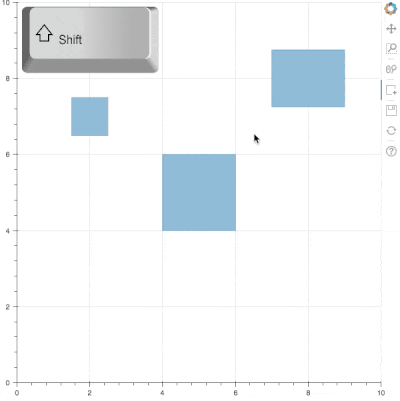
The animation above shows the supported tool actions, highlighting
mouse actions with a circle around the cursor, and key strokes by
showing the pressed keys. The BoxEditTool can Add, Move
and Delete boxes on plots:
- Add box
Hold shift, then click and drag anywhere on the plot or double tap once to start drawing. Move the mouse and double tap again to finish drawing.
- Move box
Click and drag an existing box. The box will be dropped once you let go of the mouse button.
- Delete box
Tap a box to select it, then press the BACKSPACE key while the mouse is within the plot area.
To Move or Delete multiple boxes at once:
- Move selection
Select box(es) with SHIFT+tap (or another selection tool) then drag anywhere on the plot. Selecting and then dragging on a specific box will move both.
- Delete selection
Select box(es) with SHIFT+tap (or another selection tool) then press BACKSPACE while the mouse is within the plot area.
FreehandDrawTool¶
The FreehandDrawTool() allows freehand drawing of lines and polygons
using the Patches and MultiLine glyphs, by editing the
underlying ColumnDataSource data. Like other drawing tools,
you must pass the renderers to be edited as a list:
r = p.multi_line('xs', 'ys' source=source)
tool = FreehandDrawTool(renderers=[r])
The tool automatically modifies the columns on the data source
corresponding to the xs and ys values of the glyph. Any
additional columns in the data source will be padded with the declared
empty_value when adding a new point. Any newly added points will
be inserted in the ColumnDataSource of the first supplied
renderer.
It is also often useful to limit the number of elements that can be
drawn. For example, when specifying a specific number of regions of interest.
Using the num_objects property, you can ensure that once the limit
has been reached, the oldest patch/multi-line will be popped off the
queue to make space for the new patch/multi-line being added.
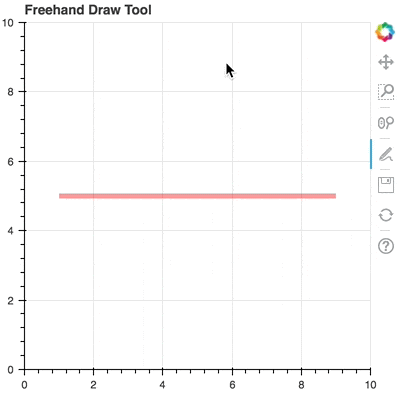
The animation above shows the supported tool actions, highlighting
mouse actions with a circle around the cursor, and key strokes by
showing the pressed keys. The PolyDrawTool can Draw and
Delete patches and multi-lines:
- Draw patch/multi-line
Click and drag to start drawing and release the mouse button to finish drawing.
- Delete patch/multi-line
Tap a line or patch to select it then press the BACKSPACE key while the mouse is within the plot area.
To Delete multiple patches/lines at once:
- Delete selection
Select patches/lines with SHIFT+tap (or another selection tool), then press BACKSPACE while the mouse is within the plot area.
PointDrawTool¶
The PointDrawTool() allows you to add, drag, and delete point-like
glyphs (of XYGlyph type) on one or more renderers by editing the
underlying ColumnDataSource data. Like other drawing tools,
you must pass the renderers to be edited as a list:
c1 = p.circle('x', 'y', 'width', 'height', source=source)
r1 = p.rect('x', 'y', 0.1, 0.1, source=source2)
tool = PointDrawTool(renderers=[c1, r1])
The tool automatically modifies the columns on the data source
corresponding to the x and y values of the glyph. Any
additional columns in the data source will be padded with the declared
empty_value when adding a new point. Any newly added points will
be inserted in the ColumnDataSource of the first supplied
renderer.
It is also often useful to limit the number of elements that can be
drawn. Using the num_objects property, you can ensure that once the
limit has been reached, the oldest point will be popped off the queue
to make space for the new point being added.
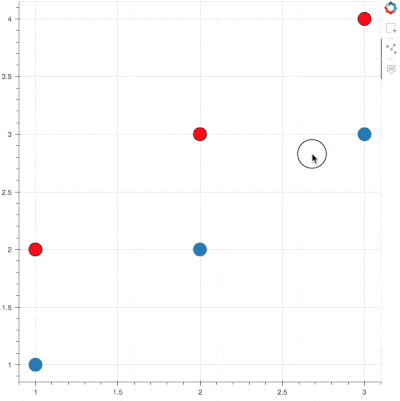
The animation above shows the supported tool actions, highlighting mouse actions with a circle around the cursor, and key strokes by showing the pressed keys. The PointDrawTool can Add, Move, and Delete point-like glyphs on plots:
- Add point
Tap anywhere on the plot.
- Move point
Tap and drag an existing point. The point will be dropped once you let go of the mouse button.
- Delete point
Tap a point to select it then press BACKSPACE key while the mouse is within the plot area.
To Move or Delete multiple points at once:
- Move selection
Select point(s) with SHIFT+tap (or another selection tool), then drag anywhere on the plot. Selecting and then dragging a specific point will move both.
- Delete selection
Select point(s) with SHIFT+tap (or another selection tool), then press BACKSPACE while the mouse is within the plot area.
PolyDrawTool¶
The PolyDrawTool() allows you to draw, select, and delete
Patches and MultiLine glyphs on one or more renderers by
editing the underlying ColumnDataSource data. Like other drawing tools,
you must pass the renderers to be edited as a list.
The tool automatically modifies the columns on the data source
corresponding to the xs and ys values of the glyph. Any
additional columns in the data source will be padded with the declared
empty_value, when adding a new point. Any newly added patch or
multi-line will be inserted on the ColumnDataSource of the first
supplied renderer.
It is also often useful to limit the number of elements that can be
drawn. For example, when specifying a specific number of regions of interest.
Using the num_objects property, you can ensure that once the limit
has been reached the oldest patch/multi-line will be popped off the
queue to make space for the new patch/multi-line being added.
If a vertex_renderer with a point-like glyph is supplied, the
PolyDrawTool will use it to display the vertices of the
multi-lines/patches on all supplied renderers. This also enables the
ability to snap to existing vertices while drawing.
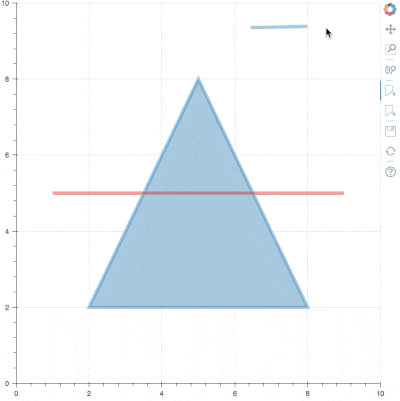
The animation above shows the supported tool actions, highlighting
mouse actions with a circle around the cursor, and key strokes by
showing the pressed keys. The PolyDrawTool can Add, Move,
and Delete patches and multi-lines:
- Add patch/multi-line
Double tap to add the first vertex, then use tap to add each subsequent vertex. To finalize the draw action, double tap to insert the final vertex or press the ESC key.
- Move patch/multi-line
Tap and drag an existing patch/multi-line. The point will be dropped once you let go of the mouse button.
- Delete patch/multi-line
Tap a patch/multi-line to select it, then press the BACKSPACE key while the mouse is within the plot area.
PolyEditTool¶
The PolyEditTool() allows you to edit the vertices of one or more
Patches or MultiLine glyphs. You can define the glyphs to be
edited with the renderers property. You can define the renderer
for the vertices with the vertex_renderer. It must
render a point-like Glyph (of XYGlyph type).
The tool automatically modifies the columns on the data source
corresponding to the xs and ys values of the glyph. Any
additional columns in the data source will be padded with the declared
empty_value, when adding a new point.
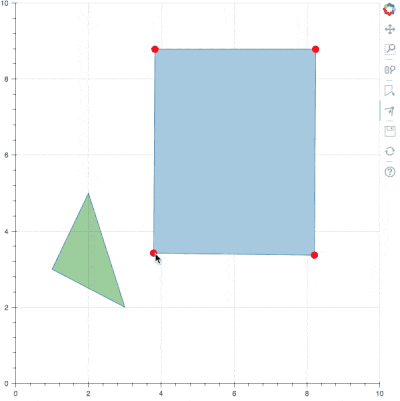
The animation above shows the supported tool actions, highlighting
mouse actions with a circle around the cursor, and key strokes by
showing the pressed keys. The PolyEditTool can Add, Move,
and Delete vertices on existing patches and multi-lines:
- Show vertices
Double tap an existing patch or multi-line.
- Add vertex
Double tap an existing vertex to select it. The tool will draw the next point. To add it, tap in a new location. To finish editing and add a point, double tap. Otherwise press the ESC key to cancel.
- Move vertex
Drag an existing vertex and let go of the mouse button to release it.
- Delete vertex
After selecting one or more vertices, press BACKSPACE while the mouse cursor is within the plot area.
Controlling level of detail¶
Although the HTML canvas can comfortably display tens or even hundreds of thousands of glyphs, doing so can have adverse effects on interactive performance. In order to accommodate large data sizes, Bokeh plots offer “Level of Detail” (LOD) capability in the client.
Note
Another option when dealing with very large data volumes is to use the Bokeh Server to perform downsampling on data before it is sent to the browser. Such an approach is unavoidable past a certain data size. See Running a Bokeh server for more information.
To maintain performance while handling large data sizes, the plot only draws
a small fraction of data points during interactive operations (panning
or zooming, for example). There are four properties on Plot objects that
control LOD behavior:
- lod_interval = 300¶
- Type
Interval (in ms) during which an interactive tool event will enable level-of-detail downsampling.
- lod_threshold = 2000¶
-
A number of data points, above which level-of-detail downsampling may be performed by glyph renderers. Set to
Noneto disable any level-of-detail downsampling.
















